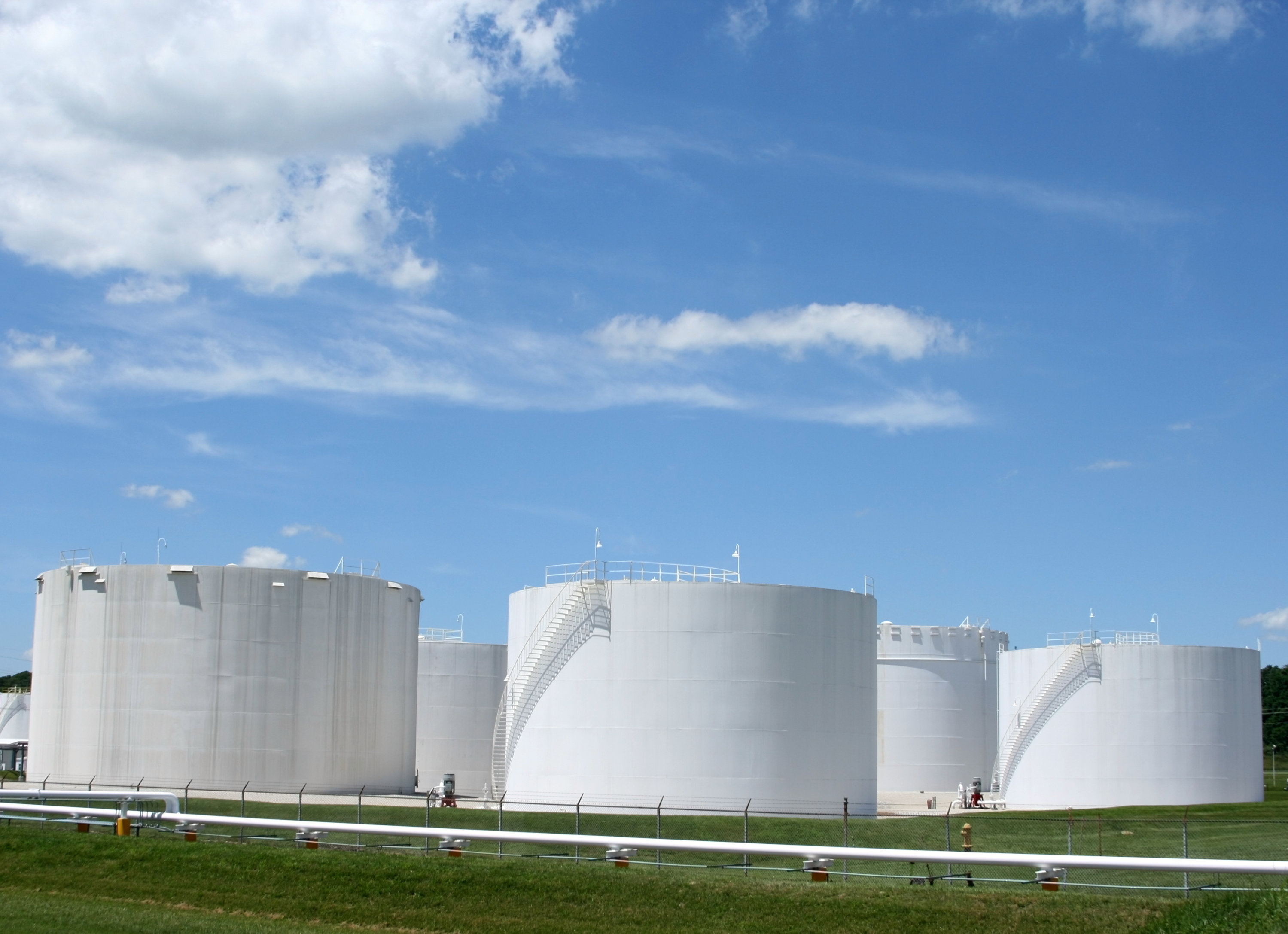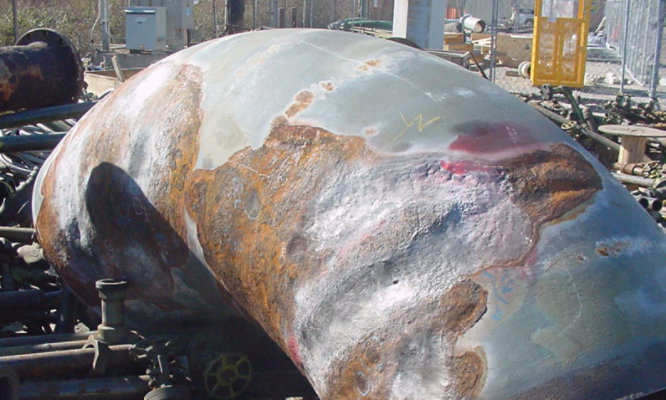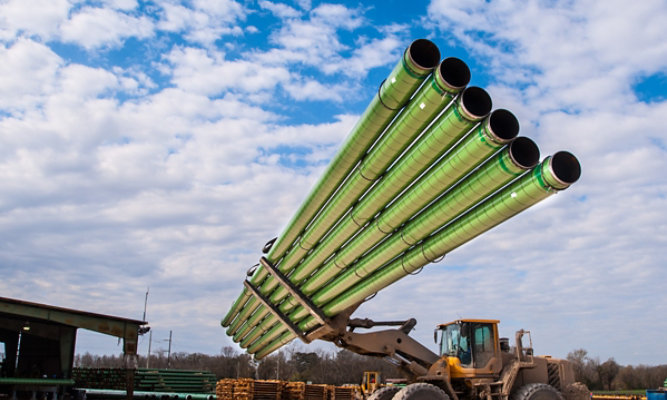
Oil & Gas Tank Lining Innovation in a Changing Industry
Novolac Technology from Sherwin-Williams Enhances Corrosion and Abrasion Resistance While Improving Application Characteristics for Oil & Gas Tank Linings
By Michael Harrison, Global Product Director – Linings,
Sherwin-Williams Protective & Marine
Tank linings are the workhorses of asset protection in the Oil & Gas market. These coatings provide a critical barrier between a stored product and the tank in which it’s contained. Without them, the risk of corrosion and material degradation is high, which is why Sherwin-Williams Protective & Marine offers lining solutions for nearly every asset in the Oil & Gas supply chain.
There are several factors to consider when specifying tank linings for various assets in each phase of the value stream. Performance requirements, such as temperature and chemical tolerance, and corrosion resistance, will dictate the type of tank lining needed to protect processing equipment, transportation vessels and storage tanks. Business and market conditions, such as supply, demand, resource availability and budgets, can also influence tank lining specifications.
In today’s Oil & Gas market, applicators and asset owners must accommodate shifting demands, limiting downtime and balancing resources to maintain profitability – all while meeting American Petroleum Institute (API) standards. Selecting the right tank lining can provide long-term savings for both parties, which is why it’s important to understand the technology and development behind modern or “next-generation” linings.
Have questions? Let's talk.
THE HISTORY OF TANK LININGS
Since the 1980s, technological advancements have changed the way chemicals are processed and stored, particularly within the Oil & Gas market. Sherwin-Williams has been an industry leader in the development of linings for more than three decades and was one of the first companies to introduce a solvent-free epoxy lining to the market. Sherwin-Williams also pioneered fast return to service linings through its Opti-Check™ Optically Active Pigment (OAP) and styrene-free vinyl ester technologies.
To view the history of linings in the coatings industry, refer to Table 1, which outlines chemical-resistant lining technologies and specifications throughout the past few decades.
TABLE 1: HISTORY OF CHEMICAL-RESISTANT LININGS
| TIMEFRAME/YEAR | TECHNOLOGY OR SPECIFICATION |
PROPERTIES |
|---|---|---|
| TIMEFRAME/YEAR Pre-1980 |
TECHNOLOGY OR SPECIFICATION Coal Tar Epoxies |
PROPERTIES
• Listed as a carcinogen in the U.S. in 1980 • Used in crude and water immersion |
| TIMEFRAME/YEAR Pre-1980 |
TECHNOLOGY OR SPECIFICATION Thin-Film Epoxies |
PROPERTIES
• Low solids and multiple coats required • Used for ambient crude and white oil storage |
| TIMEFRAME/YEAR Pre-1980 |
TECHNOLOGY OR SPECIFICATION Reinforced Lining Schemes (Epoxies and Polyesters) |
PROPERTIES
• Complex application • High cost • Refurbishment and long life expectancy schemes |
| TIMEFRAME/YEAR 1980s |
TECHNOLOGY OR SPECIFICATION First-Generation Solvent-Free Epoxies |
PROPERTIES
• Poor application properties • Used for ambient crude and white oils |
| TIMEFRAME/YEAR 1980s |
TECHNOLOGY OR SPECIFICATION Glass Flake Vinyl Esters |
PROPERTIES
• Extreme health and safety issues • Only option for high-temperature, high-pressure process vessels • Prevalent when CO2 injections were causing issues |
| TIMEFRAME/YEAR 1990s |
TECHNOLOGY OR SPECIFICATION Second-Generation Solvent-Free Epoxies |
PROPERTIES
• Used for crude oil and refined petrochemicals • First linings to offer “proven” long life cycle for new construction and maintenance applications |
| TIMEFRAME/YEAR 1990s |
TECHNOLOGY OR SPECIFICATION First-Generation Epoxy Phenolic Novolacs |
PROPERTIES
• Able to withstand high temperatures and high pressures • Medium solids |
| TIMEFRAME/YEAR 1990s |
TECHNOLOGY OR SPECIFICATION First-Generation Solvent-Free Epoxy Phenolics |
PROPERTIES • Plural and single-leg applied linings for high-temperature service |
| TIMEFRAME/YEAR 2000 |
TECHNOLOGY OR SPECIFICATION MIL-PRF-23236 Introduced |
PROPERTIES
• Requirement instated to ensure longer lining life and easier inspection • Inspection methods introduced for edge-retentive coatings |
| TIMEFRAME/YEAR 2000s |
TECHNOLOGY OR SPECIFICATION Solvent-Free Epoxies for Ballast & Navy Fuel in MIL-PRF-23236 |
PROPERTIES • First use of solvent-free linings in the U.S. Navy |
| TIMEFRAME/YEAR 2000-2010s |
TECHNOLOGY OR SPECIFICATION Epoxy Novolacs |
PROPERTIES
• Proven long life for these schemes since launching • Edge retention and optical inspection techniques become standard on high-performance tank linings |
CHANGING PERFORMANCE REQUIREMENTS
Performance requirements for Oil & Gas protective linings have changed drastically since their inception. Before the use of tank linings, crude oils, heavy fuel oils and diesels were considered non-corrosive – a theory that was proven wrong when water and acid contamination led to severe corrosion and “pitted” tank bottoms. Also, previous lining technologies did not address microbiologically-induced corrosion, which is a major source of internal corrosion in mild steel storage tanks across various markets.
Refer to Table 2 for additional performance requirement changes.
TABLE 2: CHANGES IN LINING PERFORMANCE REQUIREMENTS 1960S – PRESENT
| VARIABLE | MID-LATE 20TH CENTURY | 2010s |
|---|---|---|
| VARIABLE Chemical | MID-LATE 20TH CENTURY Crude oil – heated for loading and unloading | 2010s Shale oil and higher temperature / acidic crude oils |
| VARIABLE Storage | MID-LATE 20TH CENTURY Storage of simple, refined petrochemicals | 2010s Biodiesel (vegetable oil-based) – alcohol and acid content are a concern |
| VARIABLE Tanks | MID-LATE 20TH CENTURY Often unlined as the corrosive nature of crude and refined petrochemicals was underestimated | 2010s Bioethanol and other alcohol modifications can have a negative effect on the welds in mild steel storage tanks |
| VARIABLE Fuel Additives |
MID-LATE 20TH CENTURY
Oxygenates (ethers, etc.) fuel dyes, antioxidants etc., have changed the effect the fuel has on linings and steel Many of the additives are diluted with methanol, which causes the fuel to become much more aggressive and damaging to traditional linings |
2010s Unleaded gasoline is more aggressive to linings and mild steel tanks due to alcohol content |
| VARIABLE Purity of Stored Material | MID-LATE 20TH CENTURY Originally, simple requirements for drinking water (taste and appearance) and aviation fuels |
2010s
Increased global purity requirements for potable water (low permitted extraction limits) and high purity demands for aviation fuel cited in EI Standard 1541. Purity of other chemicals is another increasing demand going forward (e.g., sulphuric acid and glycols) |
| VARIABLE Increased Aggressive Nature of Crude Oil | MID-LATE 20TH CENTURY N/A |
2010s
High sulfur crudes – amine scrubbers Increased volume of crude oil transported by rail |
| VARIABLE Increased Demand for Long Lining Life | MID-LATE 20TH CENTURY N/A | 2010s Performance of quality linings confirmed as tanks come out of service |
Advances in technology, a wider understanding of chemistry and significant updates to legislation demand that linings provide wider chemical and temperature resistance over a longer period. After years of studying performance in the field, industry experts understand the required characteristics of modern Oil & Gas linings, not just during construction stages, but during post-build and maintenance too.
This in-depth knowledge has enabled Oil & Gas professionals to make intelligent, informed decisions when choosing the right lining. Demonstrating superior performance, ultra-high solids (UHS), solvent-free, edge-retentive linings are now the standard – enhancing flexibility and improving long life expectancy.
ACHIEVING API STANDARDS
Tank linings must comply with lifecycle requirements for them to meet API standard guidelines. The API provides a framework and guidance on construction, protection and inspection of above-ground steel storage tanks. See Appendix A for API guidance on tank linings.
PERFORMANCE CHARACTERISTICS OF MODERN LININGS
When introducing any new product to the market, Sherwin-Williams analyzes its end use and identifies ways in which the product can be safer, and more reliable and cost-effective within its application. For tank linings, Sherwin-Williams engineers products with long service life, ease of inspection and ease of application top-of-mind.
LONG SERVICE LIFE
Sherwin-Williams can generate better service times and improve lifecycle costs by developing coatings that have increased flexibility, chemical resistance and edge retention. As a full-service solutions provider, Sherwin-Williams is committed to optimizing and evolving its robust product portfolio to ensure assets and long-term investments are protected.
EASE OF INSPECTION
For tank linings, inspection processes should be considered at an early stage. In accordance with The Society for Protective Coatings (SSPC) TU 11 standards and by collaborating with leading UV flashlight manufacturers, Sherwin-Williams has developed linings with OAP technology. These linings provide an efficient and effective visual inspection of epoxy coatings for industrial applications. Sherwin-Williams has also developed linings with superior edge retention to ensure that materials are operating at optimal performance upon inspection.
EASE OF APPLICATION
The demand for improved productivity has led to the development of products that can be applied during wider application windows, within wider temperature and humidity ranges, and through multiple coats within one day. Sherwin-Williams has formulated products for ease of application and fast return to service.
PURITY
The ability to maintain purity in key materials in the Oil & Gas industry is crucial. New Sherwin-Williams tank lining technology complies with the globally recognized EI Standard 1541 – Requirements for Internal Protective Coating Systems used in Aviation Fuel Handling Systems – which includes several strict purity requirements to be met once fuel has been exposed to the lining.
UHS, SOLVENT-FREE, EDGE-RETENTIVE
LINING PERFORMANCE, BASED ON
10-YEAR INSPECTION
Visual inspection of a lining after 10+ year inspection shows no degradation other than a light surface staining from the stored chemical
- 20-30 mils (500-750μm) lining thickness remaining (no observable loss)
- Ease of cleaning allows for improved inspection
- Only slight corrosion identified due to mechanical damage of the lining
- Adhesion values of ~ 2200psi (15MPa)
- Tank returned to service with anticipated additional 20 years lifetime
THE “NEXT-GENERATION” OF TANK LININGS: NOVA-PLATE® 360
Lining technology is always changing. Merely replacing what was there previously is not an option – it is important to improve and evolve linings to meet shifting market requirements.
With the increasing demands in the Oil & Gas industry (on temperatures, pressures and aggressive chemical exposure), Sherwin-Williams has developed Nova-Plate 360, a flake-reinforced novolac tank lining. This highly crosslinked lining utilizes the latest novolac and multifunctional curative technology and is the first product of its kind.
Nova-Plate 360 provides exceptional resistance against increasingly aggressive solvents and can withstand greater temperatures and pressures. This lining minimizes asset downtime and saves time during the inspection process.
Sherwin-Williams deployed the product development process with the following intentions in mind:
- The polymer (resin) system was optimized for chemical resistance without compromising flexibility – a key requirement for long lining life, pot life and cure time.
- The pigmentation was selected to safeguard chemical resistance and barrier properties. Advanced technology was used to bind the pigments into the resin, which enhances performance and reinforces the film while maintaining the viscosity required for all common application methods (airless, plural and others).
- Aluminum oxide was incorporated to enhance abrasion resistance.
- PTFE, a hydrophobic additive with exceptional chemical resistance, was included to optimize and enhance cleaning properties without impacting the lining’s ability to adhere to steel or overcoating properties.
- Opti-Check™ OAP was incorporated to assist with inspection – reducing the reliance on high voltage spark testing.
All of these features were finely tuned and balanced to ensure that performance and application characteristics were not compromised. A key competitive lining was used for comparison during every stage of development to ensure performance was ahead of current products in the market.
For reference, Table 3 displays testing results for Nova-Plate 360.
TABLE 3: NOVA-PLATE 360 PERFORMANCE TESTING
| TEST TYPES | COMPLETED TESTS |
|---|---|
| TEST TYPES Application and Inspection |
COMPLETED TESTS
1. Airless spray (low ratio) 2. Plural airless 3. OAP demonstration |
| TEST TYPES Mechanical Properties |
COMPLETED TESTS
1. Hardness 2. Adhesion to steel 3. Adhesion to self 4. Impact 5. Flexibility 6. Abrasion 7. Edge retention |
| TEST TYPES Isothermal Immersion Testing | COMPLETED TESTS NACE TM0174 & ISO 2812 – for approvals and chemical resistance guide – there has been significant third-party testing |
| TEST TYPES Auto-Clave Testing | COMPLETED TESTS Third-party testing in hydrocarbon, water and sour gas blends |
NOVA-PLATE 360 AND API
For storage tanks, it is vital to follow API 652 for the correct selection and application of linings according to service and substrate conditions. Sherwin-Williams has in-depth experience with tank linings, which has enabled it to engineer Nova-Plate 360 – a lining with a long life expectancy that meets API 652.
Standard storage tank inspections will continue to be a requirement of API 653 to ensure optimum life. The integral design of linings can also be used to simplify the inspection process through the following characteristics:
- By intentionally designing Nova-Plate 360 to be abrasion resistant and easy to clean, this lining simplifies the emptying, cleaning and inspection processes. Ease of cleaning and reduced damage can offer significant time and money savings over the life of the tank.
- Enhancements with optically active pigments offer benefits during application, as the lining can be checked for pin holes. The use of UV lamps during planned inspections will also identify any damage to the lining, which may not be visible to the naked eye, especially because spark testing after service is not recommended.
- New in-situ methods are becoming available, which allow for quicker predictive inspection of storage tanks. Nova-Plate 360 is designed to be compatible with such inspection techniques. These methods are accepted as API 653-compliant, and combined with long-life linings, offer potential huge savings in inspection costs over the projected life of a tank.
FULFILLING THE NEED FOR LONGER SERVICE LIFE
To meet market demands, Sherwin-Williams needed to develop a new product, integrating novolac chemistry with binding technology. Nova-Plate 360 meets these stringent market requirements in terms of performance and price, and it exhibits improved application properties.
Not only does Nova-Plate 360 enable time savings through application and cure, but its OAP technology immediately identifies holidays and missed areas, allowing rectifications to be made instantly. The UHS technology and capability can be applied over a wide range of thicknesses (15-50 mils) too, making this lining suitable for new construction and maintenance projects, where application over pitted surfaces is required.
The ability to resist aggressive materials has become increasingly important for 21st-century tanks, which often house biofuels and oxygenated gasoline. Unlike its predecessors, Nova-Plate 360 can withstand these aggressive chemicals at high temperatures and pressures – showcasing its superior performance and high end-use versatility.
API 652 and API 653 will likely remain the key lining selection and inspection standards in the market for quite some time. By developing products based on new technology, iterations and learnings, Sherwin-Williams has proved time and cost savings can be achieved. This product has proven that next-generation linings can reduce complexity for owners and specifiers.
CITATIONS
- API RP 652 Linings of Aboveground Petroleum Storage Tank Bottoms, Fifth Edition
- API Std 653 Tank Inspection, Repair, Alteration, and Reconstruction, Fifth Edition, Includes Addendum 1 (2018), Addendum 2 (2020), and Errata 1 (2020)
- EI Standard 1541 Requirements for internal protective coating systems used in aviation fuel handling systems
- MIL-PRF-23236D, Performance Specification: Coating Systems for Ship Structures (15 Sep 2009)
- ASTM D4541-17> Standard Test Method for Pull-Off Strength of Coatings Using Portable Adhesion Testers
- NACE TM0174-2002, Laboratory Methods for the Evaluation of Protective Coatings and Lining Materials on Metallic Substrates in Immersion Service
- ISO 2812-2:2018 Paints and varnishes — Determination of resistance to liquids — Part 2: Water immersion method
- TM0185-2006-SG, Evaluation of Internal Plastic Coatings for Corrosion Control of Tubular Goods by Autoclave Testing
APPENDIX A: API STANDARDS
The API provides a framework and guidance on construction, protection and inspection of above-ground steel storage tanks, including
- API 650: Offers guidance on tank construction
- API 651: Suggests best use of cathodic protection
- API 652: Reviews the types and selection of linings for protection of storage tanks
- API 653: Gives direction on inspection intervals and how linings can assist in increasing them
API 652 provides thorough guidance on the selection of a lining and partial direction on the type of lining that should be used, but ultimately, lining selection is decided by the specification or engineer. Lining selection is left in the hands of the supplier, considering that generic linings may not perform the same. API 652 is based on the following criteria:
- Condition of the substrate
- Tank history (including repairs, subsidence, previous cargo)
- Stored material (temperature, approvals, purity and flexibility)
- Durability
API 652 also stresses the importance of surface preparation and application to achieve desired lining performance. Quality linings suppliers will offer high levels of inspection during application to help ensure the optimum performance of the lining.
Each category has varying performance and application characteristics.
Subsequent inspections are determined in accordance with a risk-based inspection protocol, measured on corrosion rate; and meeting all the criteria can increase the maximum interval to 15 years.
| Thin Film (<20 mils [500μm]) | Thick Film (>20 mils [500μm]) | Thick Film Reinforced |
|---|---|---|
| Thin Film (<20 mils [500μm]) Traditional Solvent Epoxy | Thick Film (>20 mils [500μm]) Solvent-Free Epoxy | Thick Film Reinforced Solvent-Free Epoxy |
| Thin Film (<20 mils [500μm]) High-Temperature Phenolic | Thick Film (>20 mils [500μm]) Solvent-Free Epoxy Phenolic | Thick Film Reinforced Solvent-Free Epoxy Phenolic |
| Thin Film (<20 mils [500μm]) Solvent-Free Epoxy | Thick Film (>20 mils [500μm]) Glass Flake Vinyl Ester | Thick Film Reinforced Reinforced Novolacs |
| Thin Film (<20 mils [500μm]) Solvent-Free Epoxy Phenolic | Thick Film (>20 mils [500μm]) | Thick Film Reinforced |
Discover More
Industry Expertise and Innovation
See how we help customers find customized solutions for their project and application challenges.
Our Marine Expertise
Explore our industry solutions and technology to help protect your assets.
LEARN MOREProduct Lookup
Find out more about our innovative coatings for a variety of industries.
FIND A PRODUCT
